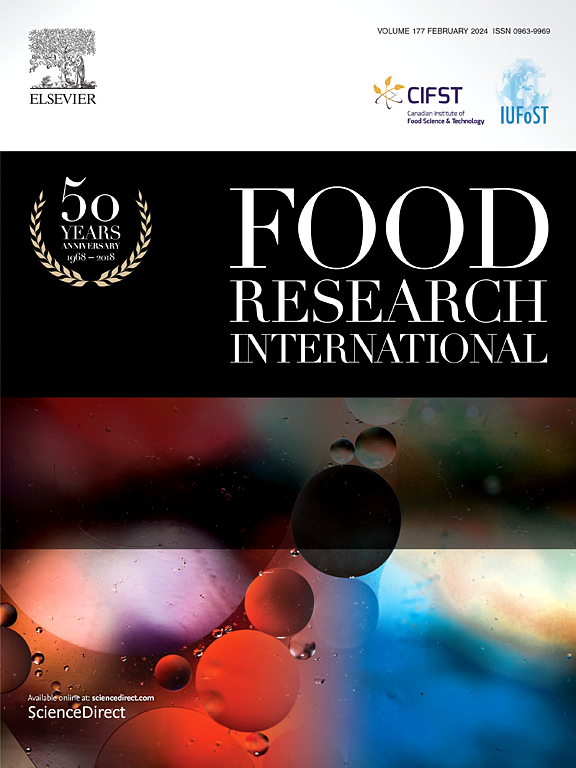探讨凝乳素和黄原胶对大米淀粉挤出过程中理化性质和多尺度结构的影响
IF 7
1区 农林科学
Q1 FOOD SCIENCE & TECHNOLOGY
引用次数: 0
摘要
水胶体在淀粉基食品中用于保水、增稠和凝胶,但它们在挤压系统中与淀粉的分子相互作用仍未得到充分探索;本研究评估了含有凝乳蛋白(CG)和黄原胶(XG)的挤出淀粉的物理化学和多尺度结构变化。CG和XG的加入显著抵消了挤压处理对淀粉多尺度结构的破坏,提高了抗性淀粉的含量。使膨化淀粉中快速消化淀粉含量降低4.99 ~ 12.40%,其中以CG含量降低幅度最大(7.99 ~ 12.40%)。抑制了内质网的退化,提高了支链淀粉的分子量(Mw: 2.39 ~ 4.43 × 108 Da),降低了糊体粘度。相对结晶度(RC)降低1.59 ~ 3.32%,短程有序度降低0.12 ~ 0.23%。而XG的作用相反,ERS-XG的降解焓(14 d)和RC分别提高了0.22 ~ 1.36 J/g和3.94 ~ 4.63%。配合物的分子量增加,颗粒结构更致密,特别是CG。本研究可为顺应挤出淀粉的发展趋势,促进人体健康提供理论依据。本文章由计算机程序翻译,如有差异,请以英文原文为准。

Exploring the effect of Curdlan and xanthan on physicochemical properties and multiscale structure of rice starch during extrusion
Hydrocolloids are utilized in starch-based foods for water-holding, thickening, and gelation, yet their molecular interactions with starch in extrusion systems remain underexplored; this study evaluates physicochemical and multiscale structural changes in extruded starch incorporating curdlan (CG) and xanthan (XG). Incorporation of CG and XG significantly counteracted the disruption of the multiscale structure of starch caused by the extrusion treatment, and increased the content of resistant starch. It reduced the content of rapidly digestible starch in extruded starch by 4.99–12.40 %, especially CG (7.99–12.40 %). The retrogradation of ERS was inhibited and the Mw of amylopectin was increased (Mw: 2.39–4.43 × 108 Da), which decreased pasting viscosity. Relative crystallinity (RC) and short-range ordering were reduced by 1.59–3.32 %, and 0.12–0.23, respectively. While XG produced the opposite effects, the enthalpies of retrogradation (14 d) and the RC of ERS-XG increased by 0.22–1.36 J/g and 3.94–4.63 %, respectively. The molecular weight of the complex was increased and the granule structure was denser, especially for CG. This study may provide theoretical basis for complying with the development trend of extruded starch for great health.
求助全文
通过发布文献求助,成功后即可免费获取论文全文。
去求助
来源期刊

Food Research International
工程技术-食品科技
CiteScore
12.50
自引率
7.40%
发文量
1183
审稿时长
79 days
期刊介绍:
Food Research International serves as a rapid dissemination platform for significant and impactful research in food science, technology, engineering, and nutrition. The journal focuses on publishing novel, high-quality, and high-impact review papers, original research papers, and letters to the editors across various disciplines in the science and technology of food. Additionally, it follows a policy of publishing special issues on topical and emergent subjects in food research or related areas. Selected, peer-reviewed papers from scientific meetings, workshops, and conferences on the science, technology, and engineering of foods are also featured in special issues.
 求助内容:
求助内容: 应助结果提醒方式:
应助结果提醒方式:


